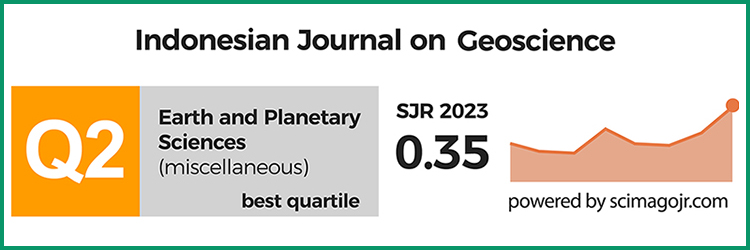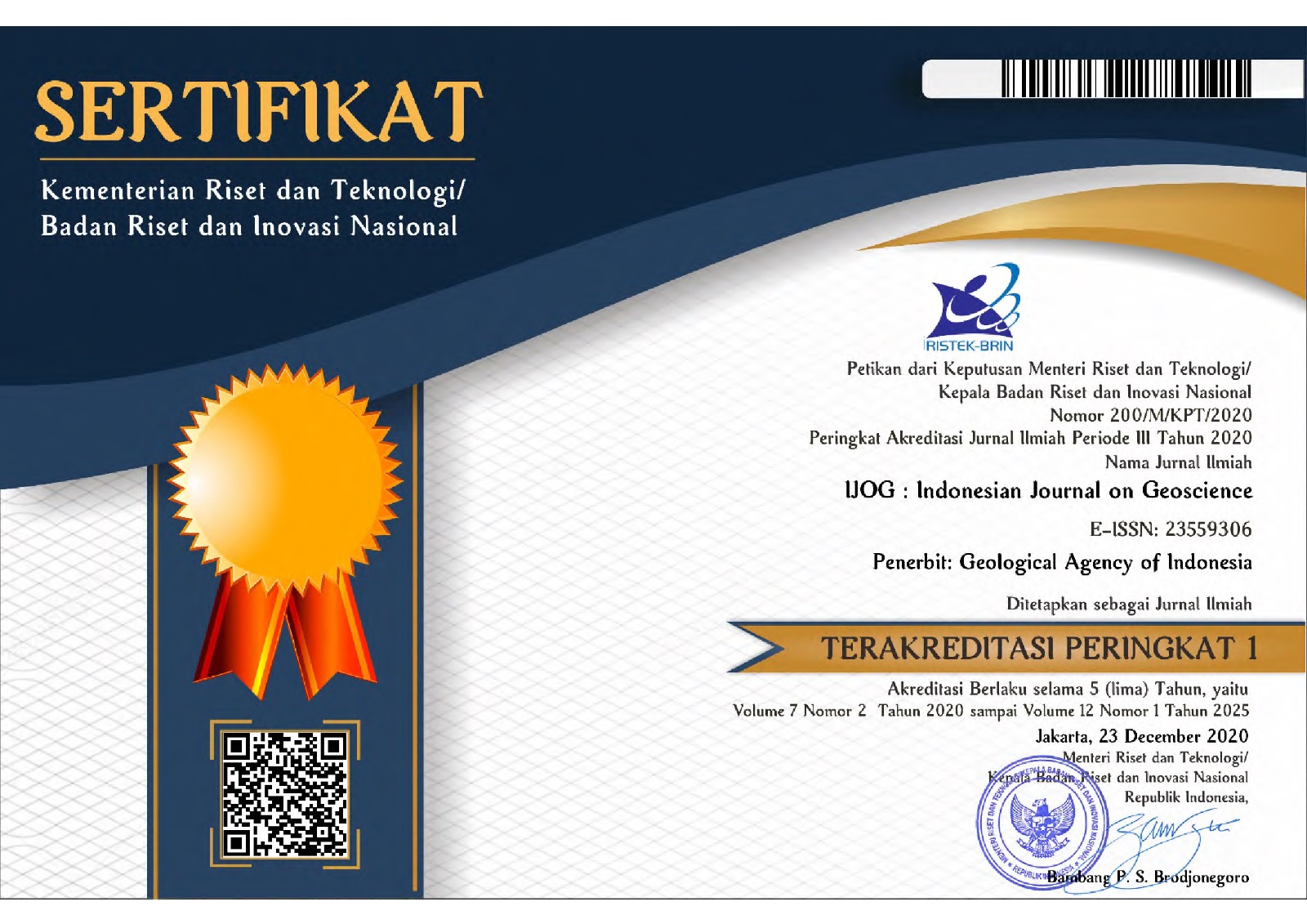Petrography and Mineral Chemistry of Magmatic and Hydrothermal Biotite in Porphyry Copper-Gold Deposits: A Tool for Understanding Mineralizing Fluid Compositional Changes During Alteration Processes
DOI:
https://doi.org/10.17014/ijog.5.1.47-64Keywords:
biotite, fluid composition change, halogen F and Cl, mineral chemistry, petrography, porphyry Cu-Au depositsAbstract
DOI: 10.17014/ijog.5.1.47-64
This study aims to understand the petrography and chemistry of both magmatic and hydrothermal biotites in porphyry copper-gold deposits, and to evaluate the fluid compositional changes during alteration processes. A total of 206 biotite grains from selected rock samples taken from the Batu Hijau porphyry Cu-Au deposit was analyzed. Detailed petrography and biotite chemistry analysis were performed on thin sections and polished thin sections, respectively, representing various rocks and alteration types. A JEOL JXA-8900R electron microprobe analyzer (EMPA) was used for the chemistry analysis. The biotite is texturally divided into magmatic and hydrothermal types. Ti, Fe, and F contents can be used to distinguish the two biotite types chemically. Some oxide and halogen contents of biotite from various rocks and alteration types demonstrate a systematic variation in chemical composition. Biotite halogen chemistry shows a systematic increase in log (XCl/XOH) and decrease in log (XF/XOH) values from biotite (potassic) through chlorite-sericite (intermediate argillic) to actinolite (inner propylitic) zones. The y-intercepts on the log (XCl/XOH) vs. XMg and log (XF/XOH) vs. XFe plotted for biotite from potassic and intermediate argillic zones are similar or slightly different. In contrast, the y-intercepts on the log (XCl/XOH) vs. XMg and log (XF/XOH) vs. XFe plotted for biotite from inner propylitic zone display different values in comparison to the two alteration zones. Halogen (F,Cl) fugacity ratios in biotite show a similar pattern: in the potassic and intermediate argillic zones they show little variation, whereas in the inner propylitic zone they are distinctly different. These features suggest the hydrothermal fluid composition remained fairly constant in the inner part of the deposit during the potassic and intermediate argillic alteration events, but changed significantly towards the outer part affected by inner propylitic alteration. High halogen content, particularly Cl, in hydrothermal biotite may portray that copper and gold were transported in mineralizing fluids in the form of chloride complexes CuCl2- and AuCl2-, respectively.
References
Afshooni, S.Z., Mirnejad, H., Esmaeily, D., and Asadi Haroni, H., 2013. Mineral chemistry of hydrothermal biotite from the Kahang porphyry copper deposit (NE Isfahan), Central Province of Iran. Ore Geology Reviews, 54, p.214-232.
Babcock, R.C., Jr., Ballantyne, G.H., and Phillips, C.H., 1995. Summary of the geology of the Bingham District, Utah. In: Pierce, F.W., and Bolm, J.G., (eds), Porphyry Copper Deposits of the American Cordillera. Arizona Geological Society Digest, 20, p.316-335.
Bao, B., Webster, J.D., Zhang, D-H., Goldo, B.A., and Zhang, R-Z., 2016. Compositions of biotite, amphibole, apatite and silicate melt inclusions from the Tongchang mine, Dexing porphyry deposit, SE China: Implications for the behavior of halogens in mineralized porphyry systems. Ore Geology Reviews, 79, p.443-462.
Beane, R.E., 1974. Biotite stability in the porphyry copper environment. Economic Geology, 69, p.241-256.
Bowman, J.R., Parry, W.T., Kropp, W.P., and Kruer, S.A., 1987. Chemical and isotopic evolution of hydrothermal solutions at Bingham, Utah: Economic Geology, 82, p.395-428.
Browne, P.R.L., 1978. Hydrothermal alteration in active geothermal fields. Annual Review of Earth and Planetary Sciences, 6, p.229-250.
Clode, C., Proffett, J., Mitchell, P., and Munajat, I., 1999. Relationships of Intrusion, Wall-Rock Alteration and Mineralisation in the Batu Hijau Copper-Gold Porphyry Deposit. Proceedings,
Pacrim Congress, Bali-Indonesia, p.485-498.
Gammons, C.H. and Williams-Jones, A.E., 1997. Chemical mobility of gold in the porphyryepithermal environment. Economic Geology, 92, p.45-59.
Garwin, S.L., 2000. The setting, geometry and timing of intrusion-related hydrothermal systems in the vicinity of the Batu Hijau porphyry copper-gold deposit, Sumbawa, Indonesia. Unpublished Ph.D Thesis, University of Western Australia, Perth, 320pp.
Garwin, S.L., 2002. The Geologic Setting of Intrusion-Related Hydrothermal Systems near the Batu Hijau Porphyry Copper-Gold Deposit, Sumbawa, Indonesia. Global Exploration Integrated Methods for Discovery, Colorado, USA. Society of Economic Geologists Special Publication, 9, p.333-366.
Gunow, A.J., Ludington, S., and Munoz, J.L., 1980. Flourine in micas from the Henderson molybdenite deposit, Colorado. Economic Geology, 75, p.1127-1137.
Idrus, A., 2005. Petrology, Geochemistry and Composional Changes of Diagnostic Hydrothermal Mineral Within the Batu Hijau Porphyry Copper-Gold Deposit, Sumbawa Island, Indonesia. Unpublished Doctor Dissertation, RWTH Aachen University, Germany, 352 pp.
Idrus, A., Kolb, J., and Meyer, F.M., 2007. Chemical composition of rock-forming minerals in copper-gold-bearing tonalite porphyry intrusions at the Batu Hijau deposit, Sumbawa Island, Indonesia: Implications for crystallisation conditions and fluorine-chlorine fugacity. Resource Geology, 57, p.102-113.
Jacobs, D.C. and Parry, W.T, 1979. Geochemistry of biotite in the Santa Rita porphyry copper deposit, New Mexico. Economic Geolology, 74, p.860-887.
Keith, J.D., Whitney, J.A., Hattori, K., Ballantyne, G.H., Christiansen, E.H., Barr, D.L., Cannan, T.M., and Hook, C.J., 1997. The role of magmatic sulphides and mafic alkalinemagmas in the Bingham and Tintic mining districts, Utah. Journal of Petrology, 38, p.1679‑1690.
Loferski, P.J. and Ayuso, R.A., 1995. Petrology and mineral chemistry of the composite Deboullie pluton, northern Maine, USA: Implication for the genesis of Cu-Mo mineralisation. Chemical Geology, 123, p.89-105.
Moradi, R., Boomeri, M., Bagheri, S., and Nakashima, K., 2016. Mineral chemistry of igneous rocks in the Lar Cu-Mo prospect, southeastern part of Iran: implications for P, T, and ƒO2. Turkish Journal of Earth Sciences, 25, p.418-433.
Munoz, J.L., 1984. F-OH and Cl-OH exchange in micas with applications to hydrothermal ore deposits. Reviews in Mineralogy, Bailey, S.W., eds., 13, p.469‑494.
Munoz, J.L., 1992. Calculation of HF and HCl fugacities from biotite compositions: revised equations. Geological Society of America, Abstract Programs, 24, A221.
Munoz, J.L. and Ludington, S.D., 1974. Flouridehydroxil exchange in biotite. American Journal of Science, 274, p.396-413.
Munoz, J.L. and Swenson, A., 1981. Chloridehydroxyl exchange in biotite and estimation of relation HCl/HF activities in hydrothermal fluids. Economic Geology, 76, p.2212-2221.
Parry, W.T., Ballantyne, J.M., and Jacobs, D.C., 1984. Geochemistry of hydrothermal sericite from Roosevelt Hot Springs and the Tictic and Santa Rita porphyry copper systems. Economic Geology, 79, p.72-86.
Parry, W.T. and Jacobs, D.C., 1975. Flourine and chlorine in biotite from Basin and Range plutons. Economic Geology, 70, p.554-558.
Rieder, M., Cavazzini, G., D`Yakonov, Y.S., Frank-Kamentskii, V.A., Gottardi, G., Guggenheim, S., Koval, P.V., Müller, G., Neiva, A.M.R., Radoslovich, E.W., Robert, J‑L., Sassi, F.P., Takeda, H., Weiss, Z., and Wones, D.R., 1998. Nomenclature of the micas. The Canadian Mineralogist, 36, p.41‑48.
Selby, D. and Nesbitt, B.E., 2000. Chemical composition of biotite from the Casino porphyry Cu-Au-Mo mineralisation, Yukon, Canada: evaluation of magmatic and hydrothermal fluid chemistry. Chemical Geology, 171, p.77-93.
Shinohara, H., 1994. Exsolution of immiscible vaper and liquid phases from a crystallizing silicate melt: Implications for chlorine and metal transport. Geochimica et Cosm chimica Acta, 58, p.5215-5221.
Turner, S.J., 1995. Fluid inclusion study of Batu Hijau porphyry Cu-Au deposit, Southwest Sumbawa, Indonesia: implications for mineralisation and metal patterns around a major porphyry stock. Unpublished Newmont Nusa Tenggara company report, 49pp.
Zhang, W., Lentz, D.R., Thorne, K.G., and Mc- Farlane, C., 2016. Geochemical characteristics of biotite from felsic intrusive rocks around the Sisson Brook W-Mo-Cu deposit, west-central New Brunswick: An indicator of halogen and oxygen fugacity of magmatic systems. Ore Geology Reviews, 77, p.82-96.
Zhu, C. and Sverjersky, D.A., 1991. Partitioning of F-Cl-OH between minerals and hydrothermal fluids. Geochimica et Cosmochimica Acta, 55, p.1837-1858.
Zhu, C. and Sverjersky, D.A., 1992. Partitioning of F-Cl-OH between biotite and apatite. Geochimica et Cosmochimica Acta, 56, p.3435-3467.



















